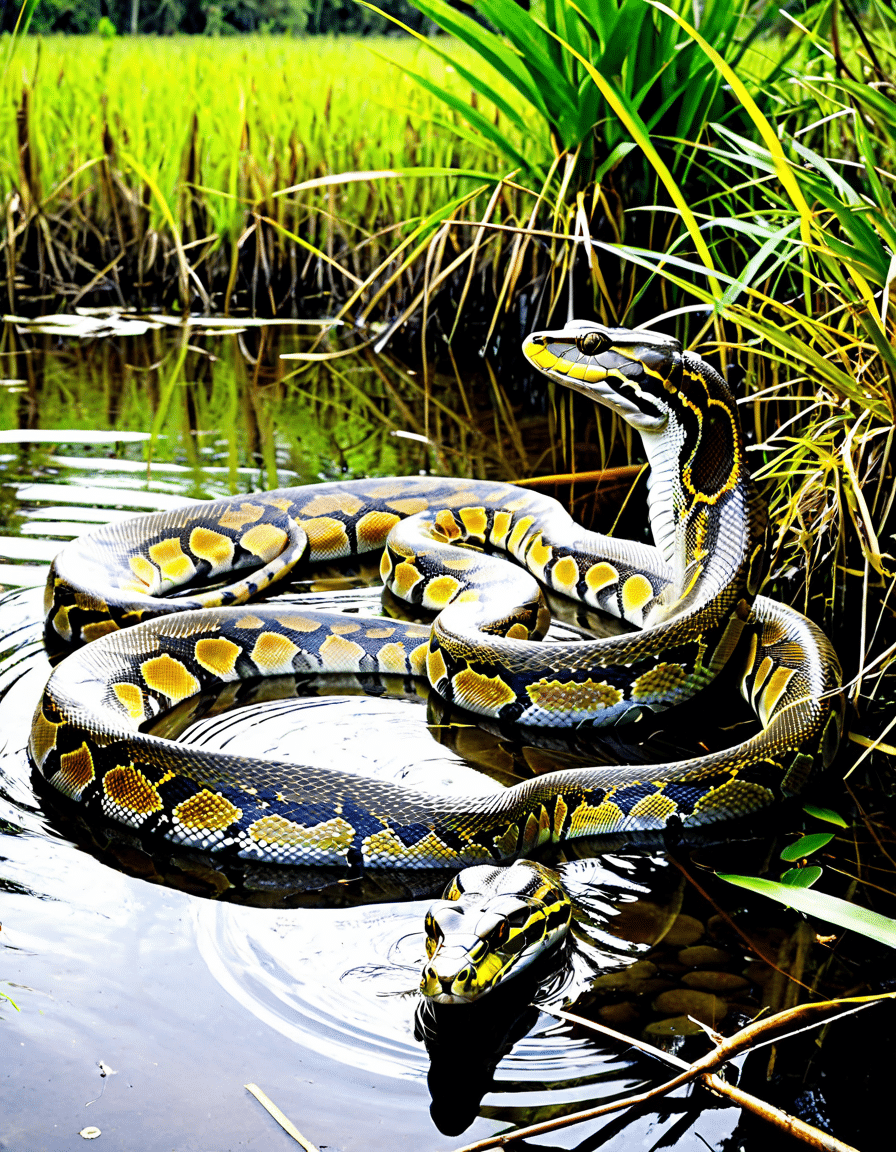Burmese pythons in Florida have become a pressing ecological issue, alarming conservationists and local communities alike. Estimates suggest that these non-native snakes have swarmed the Everglades, with numbers reaching into the tens of thousands. Originally introduced as exotic pets, Burmese pythons either escaped their confines or were deliberately released into the wild, where they have thrived due to a lack of natural predators and the subtropical climate. The consequences of their presence cannot be overstated, as they are causing significant disruption to Florida’s wildlife.
The Rise of the Burmese Python Population in Florida
The story of Burmese pythons in Florida begins with the irresponsible ownership of exotic pets. Once touted as fascinating companions, many owners misunderstood the magnitude of caring for these massive reptiles. After realizing their commitment was far more than they bargained for, some chose to release these pythons into the wild, setting the stage for ecological turmoil.
Without natural enemies, the Burmese python population exploded. The favorable climate of Southern Florida, replete with swamps and wetlands, allowed these reptiles to adapt quickly and efficiently. The staggering growth of their numbers poses a threat not only to native species but also to the delicate balance of the environments they inhabit.
Scientists and environmentalists warn that Burmese pythons have started to carve out a niche in Florida that devastates local ecosystems. As an apex predator, they effortlessly consume various native wildlife species, outcompeting them for resources and causing population declines that resonate throughout the food web.

Top 5 Ways Burmese Pythons are Impacting Florida’s Wildlife
1. Devastating Effects on Native Species
Burmese pythons are doing real damage to Florida’s biodiversity. By preying on local fauna, including raccoons, opossums, and marsh rabbits, they are leading to alarming declines in these populations. In areas heavily populated by these huge snakes, wildlife researchers have documented nearly 80% drops in these species, leading to concerns over the future health of the ecosystem.
Predation by Burmese pythons is effectively removing critical players from the food web. The impact extends well beyond individual species; entire populations vanish, meaning that routes of energy transfer in ecosystems are significantly disrupted. This predicament prompts calls for immediate action to combat this invasive threat.
2. Influence on the Ecosystem’s Food Web
The invasion of Burmese pythons in Florida has caused a significant shift in the local food web. Their predation pressure on native species is opening windows for other small species to thrive, creating an imbalance that can lead to overpopulation and overgrazing. For instance, with fewer predators around, small mammals like rodents may proliferate, ultimately affecting plant life.
Florida’s diverse ecosystems, from the vibrant coral reefs to the lush wetlands, function on a delicate balance. When one key species disappears due to predation, it reverberates through the environment—rearranging relationships, populations, and ultimately the health of these natural systems.
With the food web in turmoil, conservationists worry about the long-term ramifications for Florida’s wildlife. If this trend continues, Floridians might witness fewer bird species, diminished plant life, and an overall decline in natural beauty in the state, potentially affecting tourism—Florida’s lifeblood.
3. Economic Implications for the State
The Burmese python invasion isn’t just an environmental issue; it casts a shadow over Florida’s economic landscape as well. The state’s tourism sector, heavily reliant on its breathtaking natural beauty and vibrant wildlife, could suffer if ecological health continues to decline. A drop in wildlife sightings or ecological diversity could deter tourists, leading to financial shortfalls for local businesses and communities.
In response, state officials are forced to spend significant resources on managing the python population. Implementing tracking programs, public awareness campaigns, and various control strategies requires taxpayer dollars, straining budgets already in a pinch from other pressing needs. Floridians are not only facing environmental degradation due to Burmese pythons, but they are also feeling the economic pinch.
4. Effects on Other Invasive Species
Interestingly, the presence of Burmese pythons may inadvertently influence other invasive species in Florida. For example, they may assist in curbing the feral pig problem, as these pigs can also wreak havoc on local ecosystems. However, while this might seem like a silver lining, it doesn’t serve to buffer the overall destructive impact the pythons have on local biodiversity.
The interplay between invasive species is complex, often yielding unpredictable results. While some populations may shrink due to predation, the pressure they place on native species persists, making it essential for wildlife managers to have a broader understanding of these ecological interactions.
5. Hurdles of Control and Management Strategies
Efforts to tackle the Burmese python invasion are underway, but they face significant hurdles. Florida has launched public hunting initiatives, set traps, and implemented educational campaigns aimed at raising awareness about this invasive species. Yet, these strategies often fall short due to limited public awareness and the enormous territory covered by the pythons.
Local communities are stepping up to aid in controlling pythons, but the task is daunting given the snakes’ elusive nature. Without concerted public efforts and support, officials may struggle to develop strategies that effectively manage and eventually reduce the python population.
Case Studies: Learning from Other Invasive Species Challenges
Community Composure Amid Invasion
The parallels between the community response to the Ariel Castro kidnappings and the Burmese python invasion are striking. Just as heightened awareness led to increased vigilance in the community around Castro’s actions, the python invasion has seen Floridians become more engaged in monitoring and protecting their natural surroundings. Community awareness campaigns are drawing people to combat the threat posed by the pythons, fostering a sense of responsibility.
Public Health and Awareness Campaigns
Just like the dire consequences of methanol poisoning in Laos, underscoring a national focus on public health measures, the Burmese python crisis compels Floridians to acknowledge that ecosystems require vigilant management. The danger lurks not just in the exotic snake itself but in the ecosystem’s vulnerability when left unchecked.
Foreshadowing Through Tragedy
The tragic deaths of Australian surfers killed in Mexico serve as a reminder to respect nature’s unpredictability. Florida’s experience with its invasive species is similar; caution and preparation are crucial as locals tackle the threat of the Burmese python. Awareness campaigns focused on the risks can help the public navigate the complexities of managing invasives successfully.
Community Support as a Solution
The rise of Venezuelan gangs in Colorado has prompted community mobilization to address underlying socioeconomic issues. Similarly, facing the invasive Burmese pythons, Florida communities are rallying together to support wildlife management initiatives—realizing their actions can directly contribute to ecological conservation efforts.

Mobilizing for the Future: A Call to Action
The crisis posed by Burmese pythons in Florida isn’t merely an ecological problem; it’s a societal challenge that necessitates immediate action. Education and community involvement are vital to combat this invasive species and revitalize Florida’s wildlife.
Through proactive measures, Floridians can foster resilience in their ecosystems. By learning from previous crises and capitalizing on collective action, residents can work together to restore balance in their cherished natural landscapes. Importantly, the Burmese python invasion might be an unexpected opportunity to rally for ecological awareness and conservation that ensures the strength and stability of Florida’s wildlife for generations to come.
In this ongoing battle, every voice matters; it’s time for each of us to lend ours to the cause. After all, when we all pitch in, we’re not just fighting for the wildlife—in a way, we’re fighting for ourselves.
Burmese Pythons in Florida: Fun Trivia and Interesting Facts
Getting to Know the Invasive Snakes
Did you know that Burmese pythons in Florida have become some of the largest snakes in the wild? These snakes can grow up to 23 feet in length and weigh over 200 pounds! This extraordinary size often leads folks to wonder just how they impact local wildlife. In recent years, numerous ecological studies have shown that these snakes have decimated populations of small mammals, like raccoons and rabbits, which are essential to maintaining a balanced ecosystem. It’s almost like a prelude to a wild concert; when the balance is disrupted, the entire atmosphere changes. Just like how the infamous Coachella Trump rally brought a mix of excitement and chaos, the presence of these pythons has similarly stirred things up in Florida’s natural habitats.
Slithering Towards Trouble
The story of Burmese pythons in Florida is a jaw-dropper. According to some reports, the initial breeding population started from pets released into the Everglades over 30 years ago. What’s interesting is that these snakes can lay between 20 to 100 eggs at a time! This high reproductive rate contributes to their rapid spread across the state. It’s reminiscent of the Cybertruck recall—just when you think you’ve seen it all, more issues pop up, creating a headache for anyone trying to keep track. Florida’s conservation teams are continuously finding ways to combat these snakes, using innovative trapping methods and public awareness campaigns.
The Considerable Impacts on the Ecosystem
With the sprawl of Burmese pythons in Florida, the fallout has reached beyond individual species. Their presence is affecting the entire food chain. Remember how everyone keeps an eye on Pittsburgh Pirates news during baseball season? Well, wildlife experts are doing the same thing for local species—they’re monitoring shifts in behaviors and population dynamics. Studies have found that smaller animals are exhibiting more erratic behaviors to avoid becoming a meal for these snakes.
All this being said, it’s essential to bring to light how the ecosystem reacts, much like how Britt Stewart embraces change in her dance routines, adapting to different styles and rhythms. The consequences of an invasive species are not just limited to one area; they ripple through the entire environment. As more people become aware of the significant issues surrounding Burmese pythons in Florida, we can only hope for innovative solutions that will allow native wildlife to thrive.




